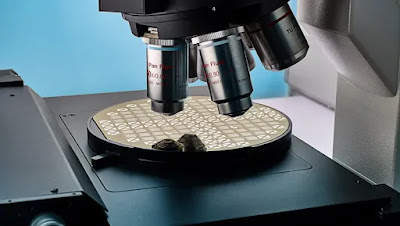Harnessing the Power of Graphene
Welcome to our educational website, where we dive into the fascinating world of graphene! In this blogpost, we'll explore the wonders of graphene, its significance in scientific and technological advancements, and its wide range of applications. Get ready to discover how this remarkable material is poised to revolutionize various industries.
Graphene, a single layer of carbon atoms arranged in a hexagonal lattice structure, holds immense potential due to its exceptional properties. From its incredible strength and electrical conductivity to its high thermal conductivity and unique optical characteristics, graphene has captured the attention of scientists and engineers worldwide.
At Knowledge Time, our goal is to provide you with a comprehensive understanding of graphene. We aim to educate and engage our readers by delving into its properties, applications, and the challenges it faces.
By optimizing this blogpost for search engines, we ensure that it reaches a wider audience and helps spread knowledge about graphene. So, let's embark on this enlightening journey and delve into the amazing world of graphene!
I. What is Graphene?
So, what exactly is graphene? Graphene is a mind-bogglingly thin yet incredibly strong material made up of a single layer of carbon atoms. Imagine a sheet of carbon atoms arranged in a hexagonal pattern. That's graphene!
Now, let's talk about the impressive properties of graphene. It's known for being exceptionally strong, even stronger than steel. Its strength comes from the tight bonding between carbon atoms, which forms a robust lattice structure. This strength makes graphene an ideal candidate for various applications requiring durability.
Another remarkable property of graphene is its electrical conductivity. It allows electrons to move through it with minimal resistance, making it an excellent conductor of electricity. This property opens up a world of possibilities for graphene in electronics and semiconductor industries.
When it comes to thermal conductivity, graphene shines bright as well. It has the ability to transfer heat quickly and efficiently, making it useful for thermal management applications. Imagine using graphene-based materials to dissipate heat from electronic devices, ensuring they stay cool even under heavy usage.
But that's not all! Graphene also possesses unique optical properties. It interacts with light in interesting ways, giving it transparency and other optical characteristics. This opens up avenues for applications in optoelectronics, sensors, and more.
Now, let's address how graphene is manufactured. There are various methods to produce graphene, including mechanical exfoliation, chemical vapor deposition, and epitaxial growth. Each method has its advantages and challenges, but researchers are continuously working to improve production techniques. So, let's continue our journey of exploration and unravel the wonders of graphene together!
II. Properties of Graphene
Now that we have a basic understanding of graphene, let's dive deeper into its exceptional properties that make it such an incredible material. From its outstanding strength to its remarkable electrical conductivity, graphene continues to amaze researchers and engineers alike.
One of the most captivating features of graphene is its exceptional strength. Despite being incredibly thin, it's remarkably strong. In fact, it's stronger than steel! The tightly bonded carbon atoms in the hexagonal lattice structure give graphene its incredible durability. This property makes it an ideal choice for applications where strength and resilience are crucial.
Another impressive property of graphene is its excellent electrical conductivity. Due to its unique structure, graphene allows electrons to flow through it with minimal resistance. This makes it an excellent conductor of electricity. Imagine graphene-based electronic devices that can operate at higher speeds and with lower power consumption. The possibilities are truly mind-boggling!
But that's not all—graphene also boasts high thermal conductivity. It efficiently transfers heat, making it a valuable material for thermal management. Imagine graphene being used to dissipate heat from electronic components, preventing overheating and ensuring optimal performance. This property has the potential to revolutionize the way we design and manufacture electronics.
Graphene's optical properties are equally fascinating. It interacts with light in intriguing ways, exhibiting unique optical characteristics. Its transparency allows light to pass through, making it suitable for applications in transparent conductors, such as touchscreens and flexible displays. Graphene's optical properties open up new possibilities in the field of optoelectronics, paving the way for advanced sensors and photonic devices.
The list of graphene's exceptional properties doesn't stop there. It's also flexible, lightweight, and impermeable. These characteristics make it an exciting material for applications in flexible electronics, composites, and even in areas such as water filtration and desalination.
III. Applications of Graphene
Now that we have explored the impressive properties of graphene, let's take a closer look at its wide range of applications. From electronics and energy storage to composite materials and biomedical advancements, graphene has the potential to revolutionize various industries.
In the realm of electronics and semiconductors, graphene holds tremendous promise. Its excellent electrical conductivity and unique properties make it an ideal candidate for the next generation of electronic devices. Graphene-based transistors and integrated circuits have the potential to outperform current technologies, offering faster speeds, lower power consumption, and even flexible and transparent displays. Imagine a future where graphene-powered smartphones, wearable devices, and flexible screens become the norm!
When it comes to energy storage, graphene is a game-changer. Its high surface area and ability to store and release energy efficiently make it suitable for applications in batteries and supercapacitors. Graphene-based batteries have the potential to charge faster, last longer, and offer higher energy density. Additionally, graphene can enhance the performance of fuel cells, enabling clean and efficient energy generation.
The use of graphene in composite materials is another exciting area. By incorporating graphene into polymers and composites, the resulting materials exhibit enhanced strength, flexibility, and lightweight properties. This opens up possibilities for the development of stronger and lighter aircraft, vehicles, and even sports equipment.
In the field of biomedicine, graphene's unique properties offer new opportunities. Graphene-based drug delivery systems have the potential to revolutionize the way medications are administered, ensuring targeted and controlled release. Furthermore, graphene's biocompatibility and conductivity make it suitable for applications in tissue engineering, biosensors, and even diagnostic devices. Imagine graphene-based implants that can monitor and stimulate tissue regeneration!
A. Electronics and Semiconductors:
Let's dive into the exciting world of electronics and semiconductors, where graphene is poised to make a significant impact. With its exceptional electrical conductivity and unique properties, graphene holds immense promise for the future of electronic devices. Imagine faster and more powerful smartphones, tablets, and computers powered by graphene-based transistors and integrated circuits. These advancements can lead to improved performance, lower power consumption, and even flexible and transparent displays. Graphene is revolutionizing the way we envision and develop next-generation electronics.
B. Energy Storage:
When it comes to energy storage, graphene is a game-changer. Its high surface area and remarkable energy storage capabilities make it ideal for applications in batteries and supercapacitors. Graphene-based batteries have the potential to charge faster, last longer, and offer higher energy density, paving the way for more efficient electric vehicles, portable devices, and renewable energy storage. Additionally, graphene's properties can enhance the performance of fuel cells, enabling clean and sustainable energy generation. With graphene, we're unlocking new possibilities for efficient and eco-friendly energy storage solutions.
C. Composite Materials:
Graphene's exceptional properties make it an excellent candidate for enhancing the performance of composite materials. By incorporating graphene into polymers and composites, we can create materials with enhanced strength, flexibility, and lightweight characteristics. Imagine aircraft and vehicles that are not only stronger but also lighter, resulting in improved fuel efficiency and reduced emissions. Graphene-infused composites also have the potential to enhance the durability and performance of sports equipment, making them lighter and more robust. The application of graphene in composite materials is pushing the boundaries of what we can achieve in terms of strength, weight, and sustainability.
D. Biomedical Applications:
In the field of biomedicine, graphene's unique properties are opening up new frontiers. Graphene-based drug delivery systems offer targeted and controlled release of medications, improving treatment effectiveness while minimizing side effects. Moreover, graphene's biocompatibility and conductivity make it suitable for various biomedical applications. It can be used in tissue engineering to create scaffolds that promote tissue regeneration, opening possibilities for organ and tissue transplants. Graphene-based biosensors and diagnostic devices enable accurate and sensitive detection of diseases and biomarkers, leading to early diagnosis and personalized healthcare. The potential impact of graphene on biomedicine is tremendous, offering breakthroughs in drug delivery, tissue engineering, and diagnostics.
IV. Challenges and Limitations
As remarkable as graphene is, it also faces certain challenges and limitations that need to be addressed for its widespread adoption. Let's take a closer look at some of these challenges and explore the ongoing efforts to overcome them.
A. Production and Scalability:
One of the primary challenges with graphene lies in its large-scale production. While researchers have made significant progress in manufacturing techniques, there is still a need to develop cost-effective and scalable methods to produce graphene in substantial quantities. The ability to mass-produce graphene is crucial for its integration into various industries and applications. Ongoing research and advancements in production methods aim to address this challenge and make graphene more accessible.
B. Environmental Concerns:
The production and disposal of graphene also raise environmental concerns. Some methods of graphene production involve the use of harsh chemicals and high-energy processes, which can have an impact on the environment. Additionally, the disposal of graphene-based materials should be handled carefully to minimize any potential environmental risks. To mitigate these concerns, researchers are exploring greener production methods and studying the long-term environmental effects of graphene.
C. Integration with Existing Technologies:
Integrating graphene with existing technologies presents another set of challenges. Graphene's unique properties require careful consideration in terms of compatibility and integration with current manufacturing processes and equipment. Developing scalable methods to incorporate graphene into existing technologies without compromising performance or increasing costs is a complex task. Ongoing research focuses on finding innovative solutions to seamlessly integrate graphene into various industries.
D. Regulatory and Safety Considerations:
Graphene's potential applications in different fields raise important regulatory and safety considerations. As with any new material, it's essential to understand the potential health and safety risks associated with graphene. Research is ongoing to evaluate the impact of graphene on human health and the environment, leading to the establishment of guidelines and safety standards. Ensuring proper regulations and safety protocols are in place is vital for the responsible and safe use of graphene-based technologies.
V. The Future of Graphene
The future of graphene is filled with endless possibilities and exciting prospects. As researchers continue to push the boundaries of this remarkable material, let's explore what lies ahead.
A. Advancements in Electronics and Computing:
Graphene's extraordinary properties hold immense potential for advancements in electronics and computing. As graphene-based transistors and integrated circuits continue to be refined, we can expect faster and more energy-efficient devices. Flexible and transparent displays, wearable electronics, and even graphene-based quantum computing are on the horizon. The integration of graphene into these technologies can revolutionize the way we interact with electronics and usher in a new era of computing power.
B. Sustainable Energy Solutions:
Graphene's impact on the energy sector is set to grow significantly. With advancements in energy storage using graphene-based batteries and supercapacitors, we can envision a future where renewable energy sources are harnessed efficiently and sustainably. Graphene's ability to enhance the performance of fuel cells can pave the way for cleaner and more efficient energy generation. As we strive for a greener future, graphene-based solutions will play a vital role in achieving sustainable energy goals.
C. Breakthroughs in Healthcare and Biotechnology:
In the realm of healthcare and biotechnology, graphene holds immense promise. As researchers explore its potential in drug delivery systems, tissue engineering, and biosensing, we can expect breakthroughs in personalized medicine, regenerative therapies, and early disease detection. Graphene's ability to interact with biological systems at the nanoscale opens up new avenues for targeted treatments and precise diagnostics. The integration of graphene into biomedical devices and implants can improve patient outcomes and revolutionize healthcare practices.
D. Environmental and Industrial Applications:
Graphene's exceptional properties make it valuable for environmental and industrial applications. Its high strength, lightweight nature, and impermeability can lead to advancements in water filtration, desalination, and air purification systems. Graphene-based coatings and materials can enhance the durability and performance of structures, vehicles, and infrastructure. The potential to create sustainable and eco-friendly solutions using graphene is vast and holds promise for addressing environmental challenges.
Conclusion and Final Thoughts
In conclusion, graphene has emerged as a groundbreaking material with unparalleled properties and transformative potential. Its remarkable strength, exceptional electrical conductivity, high thermal conductivity, and unique optical characteristics make it a game-changer across various industries.
As we've explored in this blogpost, graphene finds applications in electronics and semiconductors, energy storage, composite materials, biomedicine, and more. From faster and more efficient electronic devices to sustainable energy solutions and advancements in healthcare, graphene is revolutionizing the way we live, work, and innovate.
While there are challenges to overcome, such as large-scale production, environmental concerns, integration with existing technologies, and regulatory considerations, researchers and scientists are actively working to address these issues. With ongoing advancements and collaborations, the barriers to widespread graphene adoption are gradually being overcome.
As we look to the future, the possibilities with graphene are truly endless. Advancements in electronics, sustainable energy, healthcare, and environmental applications are just the beginning. It's an exciting time to witness the transformative power of graphene and be part of the journey towards a more technologically advanced, sustainable, and innovative world.
Join us as we continue to explore the world of graphene, stay informed about the latest developments, and unlock the limitless possibilities that lie ahead.
THANK YOU FOR READING!!
FOLLOW FOR MORE AMAZING CONTENT
MUST READ-











.webp)







